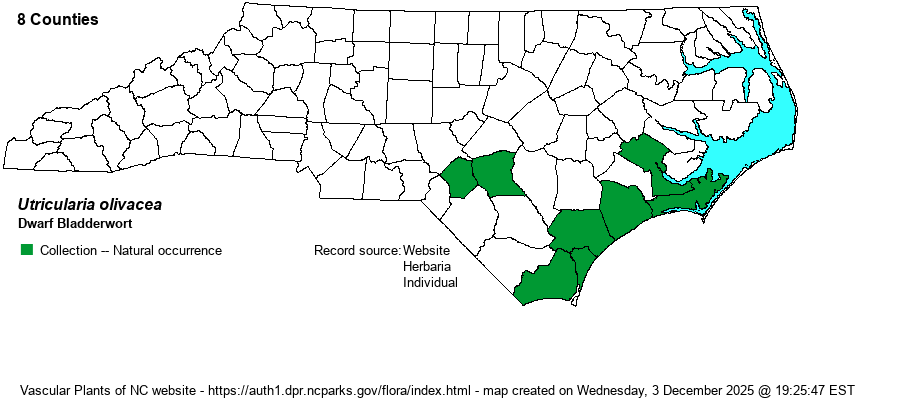| Author | Wright ex Grisebach | |
| Distribution | Restricted to the southern Coastal Plain, mainly to the coastal counties but also disjunct inland to Fort Bragg in Cumberland and Hoke counties. However, it has been found in NJ and VA, so it possibly could occur in the state's northern Coastal Plain.
Restricted to the Southeast, occurring from southeastern VA south to FL, and west to MS; disjunct north to NJ. | |
| Abundance | Rare and very easily overlooked if not in bloom. This is such a tiny species that often one encounters the plant only by seeing the white color of the tiny flowers floating on the water surface. This is a State Threatened species. | |
| Habitat | This species usually occurs in algal mats or in mats with other floating species on the surface of limesink ponds, beaver ponds, and other ponded fresh water. |
| Phenology | This is a fall-blooming species, flowering in September and October. It fruits shortly after blooming. | |
| Identification | Schnell, in Carnivorous Plants of the United States and Canada (1976), states: "This aquatic plant is considered by many to be the smallest by weight of any flowering plant in the world." It is normally seen with other species such as algae in a tangle on the surface of a pond. It has thread-like stems, but it is the white flowers -- the only Utricularia species in the state with white flowers -- that should mark it easily as that species. The "scape" is barely 2/3-1-inch long, topped by a tiny flower that is only 2 mm across (less than 1/10-inch!). Thus, when a colony is in bloom it looks like someone scattered grits over the surface of a pond. You will definitely need a hand lens or binoculars to see the typical bladderwort flower structure, not that it is needed for identification. In addition, its late blooming period, September and October, might be later than many biologists are afield in its proper pond habitat. And, needless to say, if the flowers are not visible, the plant is basically incognito. | |
| Taxonomic Comments | None
| |
| Other Common Name(s) | Minute Bladderwort, Piedmont Bladderwort (a very inappropriate name, as it basically does not occur in the Piedmont) | |
| State Rank | S1S2 | |
| Global Rank | G4 | |
| State Status | T | |
| US Status | | |
| USACE-agcp | OBL link |
| USACE-emp | OBL link |

